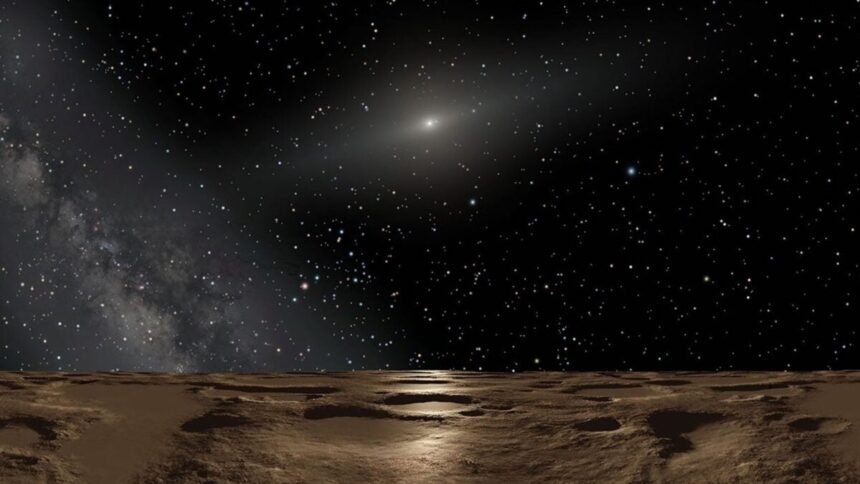On November 14, 2003, astronomers spotted what was at the time the most distant known object orbiting the Sun. They called it Sedna after the Inuit goddess of the ocean. It’s a cold, reddish dwarf planet that drifts billions of miles away from the Sun during its 10,000-year orbit before coming in for a relatively close approach to our star. Its next perihelion is happening in July 2076, and astronomers want to take advantage of this rare encounter by flying a mission to the mysterious object.
A team of researchers from Italy suggests mission concepts that could reach Sedna in seven to 10 years using cutting-edge technology. In a paper available on the pre-print website arXiv, they illustrate two experimental propulsion concepts that involve a nuclear fusion rocket engine and a new take on solar sailing technology. The propulsion technologies could cut down travel time to Sedna by more than 50% compared to traditional methods of space travel, allowing scientists a unique opportunity to gather clues about the early formation of the solar system and probe the theoretical Oort Cloud.
When it was discovered, Sedna was around 8 billion miles (13 billion kilometers) from the Sun. (Pluto, the most famous dwarf planet, has an average distance of 3.7 billion miles from the Sun.) Sedna is known as a Trans-Neptunian object, a group of objects that orbit the Sun farther out than Neptune. It has an extremely eccentric orbit: at its farthest distance, Sedna is 84 billion miles away from the Sun, or 900 times the distance between Earth and our star. During its closest approach, Sedna will be around 7 billion miles away from the Sun, nearly three times farther than Neptune. That’s still far, but it’s close enough for a spacecraft to reach the celestial object before it fades back into ultra-distant darkness.
Spacecraft have traveled farther distances before. Voyager 1 and 2 started their interstellar journey in 1977 and have traveled 15 billion miles and 12.7 billion miles thus far. It took Voyager 2 around 12 years to reach Neptune. Based on current technology, scientists estimate it would take around 20-30 years to reach Sedna during its closest approach, while using Venus, Earth, Jupiter, and Neptune as gravity assists. That would mean the launch window to reach Sedna is fast approaching, with no clear plans yet in place.
Instead, the researchers behind the new study suggest alternative methods to get us there faster. The first is the Direct Fusion Drive (DFD) rocket engine, which is currently under development at Princeton University’s Plasma Physics Laboratory. The fusion-powered rocket engine would produce both thrust and electrical power from a controlled nuclear fusion reaction, providing more power than chemical rockets.
“The DFD presents a promising alternative to conventional propulsion, offering high thrust-to-weight ratio and continuous acceleration,” the researchers write in the paper. “However, its feasibility remains subject to key engineering challenges, including plasma stability, heat dissipation, and operational longevity under deep-space radiation.” They add that, while advances are being made for fusion-based propulsion, it’s still unclear whether it can support long-duration missions and provide power for onboard instruments.
The second concept builds on existing solar sail technology, which is still experimental in its own right. Solar sails are powered by photons from the Sun, harnessing energy produced by light and using it to propel spacecraft forward. The researchers suggest coating the solar sails with material that, when heated, releases molecules or atoms and provides propulsion in a process known as thermal desorption.
The solar sail, assisted by Jupiter’s gravity, could reach Sedna in seven years due to its ability to continuously accelerate without the need to carry heavy fuel, according to the paper. The idea does come with its own set of challenges. “While solar sailing has been extensively studied for deep-space applications, its feasibility for a Sedna mission requires assessment in terms of long-duration structural integrity, propulsion efficiency, and power availability for science operations,” the paper reads.
Despite a slight time advantage, the solar sail mission would only allow for a flyby of Sedna, while the DFD engine could insert a spacecraft into the dwarf planet’s orbit for a longer mission. Either mission would provide us with the first direct observations of the previously unexplored region and help scientists better understand the larger boundary that houses the solar system.
Read the full article here












